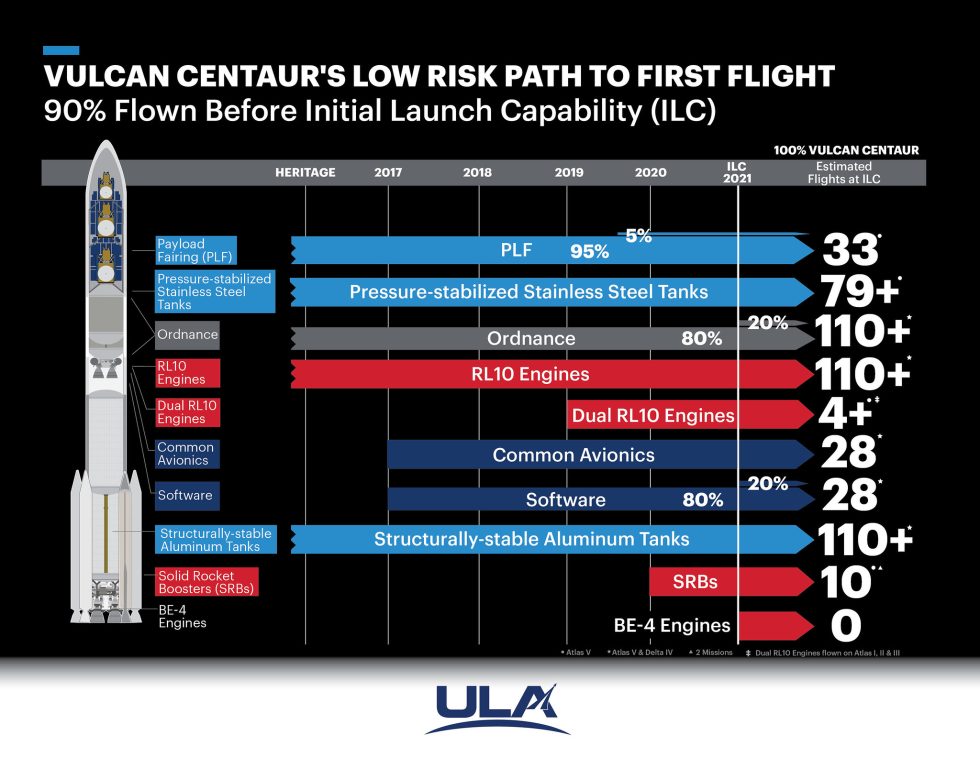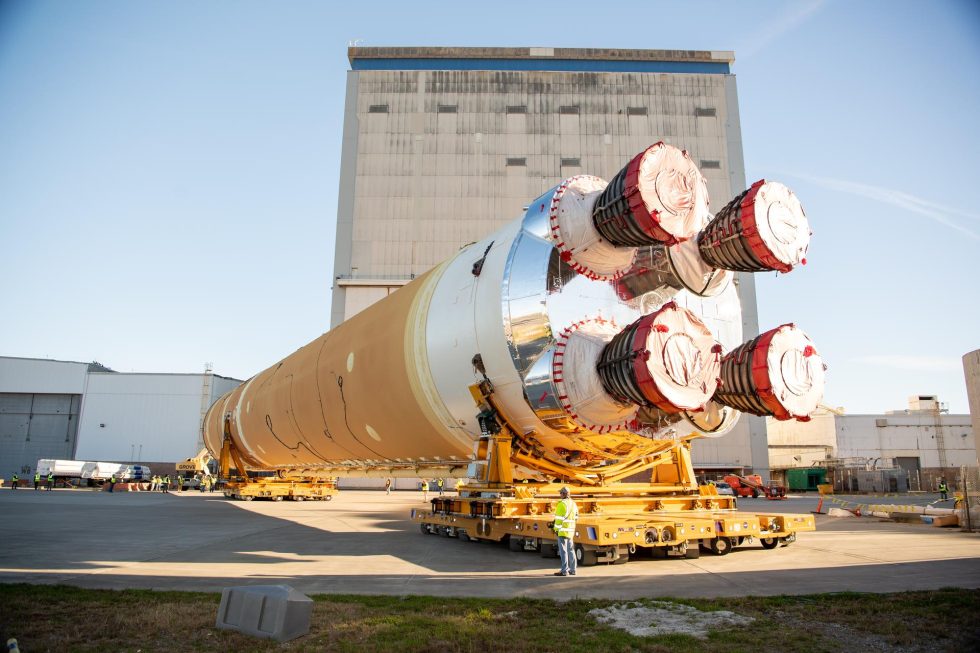
This was supposed to be the year of the big rocket. At one point, as many as four large, powerful boosters were slated to take flight this year. Alas, we now know for sure that none of them are going to make it.
Two years ago, Ars published an article outlining the four large and powerful rockets expected to make their debuts: Arianespace's Ariane 6, NASA's Space Launch System, Blue Origin's New Glenn, and United Launch Alliance's Vulcan-Centaur. Our confidence in each of these boosters launching in 2020 ranged from medium-high for the Ariane 6 (oops!) to low for New Glenn and Vulcan-Centaur.
Given that none of these rockets will, in fact, debut this year, we decided to revisit the realm of heavy lift. We will also add three more contenders for a 2021 launch: Japan's H3 rocket, Northrop Grumman's Omega booster, and SpaceX's Super Heavy first stage. Here, we try to rank these seven vehicles by which will launch soonest. Please note these are estimates based upon vastly incomplete information and are almost certainly wrong.
But hey, we're trying. And this is actually rocket science.
H3 booster
Capacity to geostationary transfer orbit (GTO): 8 tons
Current launch date: 1Q 2021
Confidence: Medium
Our estimated launch date: 2Q 2021
Mitsubishi Heavy Industries has stuck to a 2020 launch date for its H3 rocket for a while, but that comes with an asterisk because it means "fiscal year 2020," which runs through March, 2021. At one point, the company had hoped to launch the rocket during the 2020 Summer Olympics in Tokyo, which were due to begin later this month before the global pandemic. Now, we understand they're running up against the end of the fiscal year for liftoff.
Earlier this spring, the company said the COVID-19 pandemic had not slowed its efforts to bring the rocket to the launch pad during fiscal year 2020, and at present the company is continuing to push hard toward that goal.
Should the H3 rocket be on a list of heavy lift rockets? The single-stick version of the H3 rocket is not a "heavy lifter," but with four solid rocket boosters the rocket can deliver a healthy 8 tons to geostationary transfer orbit. Moreover, Japan is planning for an upgraded second stage that could deliver more than 4 tons to the Lunar Gateway, and possibly a "heavy" version with three cores that could deliver 12 tons to lunar orbit.
Omega
Capacity to GTO: 5 to 10 tons
Current launch date: Spring 2021
Confidence: Medium
Our estimated launch date: 3Q-4Q 2021
Northrop Grumman continues to make progress on its solid-fueled rocket, Omega, which it hopes the US Air Force selects for national security launches from 2022 to 2026. The Air Force is expected to decide on two providers later this summer.
There is some question as to whether Northrop will press ahead if it does not receive one of these awards—there seems to be a limited business case for Omega if the US government does not support it—but for now, we'll assume it launches at least once regardless of the Air Force's decision.
The first Omega launch does not yet have a firm date, but the company is hoping to debut the rocket from Launch Complex-39B during the first or second quarter of 2021. This is another rocket that initially does not qualify as "heavy lift." However, the company has plans for a larger version that would double Omega's lift capacity to geostationary transfer orbit. So we're including it for now.
Ariane 6
Capacity to GTO: 11.5 tons
Current launch date: 3Q-4Q 2021
Confidence: Medium-high
Our estimated launch date: 4Q 2021
This past week, the European Space Agency confirmed that the launch of the Ariane 6 rocket would slip from the end of this year into 2021. "We know that the maiden flight will not take place before the second half of 2021," Daniel Neuenschwander, the director of Space Transportation, told Ars.
Officials cited several reasons for the delay but principally blamed the COVID-19 pandemic. The disease has affected both manufacturing work at several locations in Europe as well as at the launch site in French Guiana, which shares a border with hard-hit Brazil. If tests of the integrated first and second stages of the Ariane 6 are conducted by early 2021, we'll have more confidence in a launch of this large rocket next year.
Vulcan-Centaur
Capacity to GTO: 14.4 tons
Current launch date: Summer 2021
Confidence: Medium-low
Our estimated launch date: 4Q 2021
On July 1, United Launch Alliance announced that it had taken delivery of the first "pathfinder" version of the BE-4 engine that will power its Vulcan-Centaur rocket. This will help with all manner of tests as the company presses toward the first launch of its new heavy lift rocket. However, a pathfinding engine is different from the ones (Vulcan's first stage has two main engines) that will power the rocket in flight.
Currently, the RD-180 engine (Atlas V) and RS-68 (Delta IV Heavy) power United Launch Alliance's two rockets. For some historical perspective, we looked at the time between when flight versions of those engines first arrived at the rocket factory and when the boosters first flew. It averaged out at 19.5 months. This suggests that making a launch in 2021 will be a challenge for United Launch Alliance, but it's not impossible. Given that we've heard the company is working hard toward Vulcan's first launch, we'll stick with 2021 for now.
Super Heavy
Capacity to GTO: 21 tons
Current launch date: ¯\_(ツ)_/¯
Confidence: Medium-low
Our estimated launch date: 4Q 2021
SpaceX may soon begin short test flights of its Starship vehicle. Although it is massive, Starship is merely the upper stage of its next-generation launch system. The first stage, dubbed "Super Heavy" is likely to be powered by 31 Raptor engines and will be used to boost Starship into low-Earth orbit.
Although SpaceX has focused on Starship development so far, there is a lot of commonality between the two stages—both use the same engines, similar tanks, and share the same diameter. This means that once SpaceX engineers test out a lot of the technology needed for a Starship launch, they should have a pretty good template for developing Super Heavy.
Recently, we have seen evidence that SpaceX has begun to build a "high bay" facility at its South Texas Launch Site. This is where the company will stack the rings of stainless steel that will form the structure of this rocket. So when might it attempt an orbital flight? SpaceX has been moving quite fast on the Starship project, so we're not going to rule out a flight next year. Just bear in mind that this is huge project with many uncertainties.
Space Launch System
Capacity to GTO: Approximately 20 tons
Current launch date: End of 2021
Confidence: Low
Our estimated launch date: 1Q-2Q 2022
NASA's large, expendable SLS rocket was originally supposed to launch at the end of 2016, so it is already going to be five years late. With a development cost of more than $2 billion a year, that's a very costly delay. But we have finally seen progress, with the rocket's first core stage rolling out of the factory in Louisiana early this year and moving to a test site in Mississippi.
NASA and the core stage contractor Boeing are working toward a critical test firing of the rocket and its four main engines late this fall. Once this "green run" test is complete, we'll begin to have more confidence in a launch date for the rocket. It will depend upon whether the test reveals no problems, a few small ones, or some major problems that necessitate a lengthy fix.
New Glenn
Capacity to GTO: 13 tons
Current launch date: End of 2021
Confidence: Low
Our estimated launch date: 3Q-4Q 2022
Blue Origin has spent a lot of time and money on facilities—building a large assembly building and launch site in Florida, a rocket engine factory in Alabama, and new headquarters in Washington state.
What we have not seen much of yet is physical hardware for the New Glenn rocket. The company has made important strides on developing the powerful BE-4 engine, but there are massive challenges in building tanks and plumbing for a large rocket like New Glenn and writing the software to control its flight.
Another challenge Blue Origin faces is reusing the booster right from the start. When SpaceX began catching Falcon 9 rockets, it had dozens of flights worth of data and experimentation. With New Glenn, Blue Origin will seek to catch the valuable first stage from the very beginning, which will likely necessitate additional testing before the first launch. Therefore, we think it's going to be awhile before New Glenn takes flight.
reader comments
569